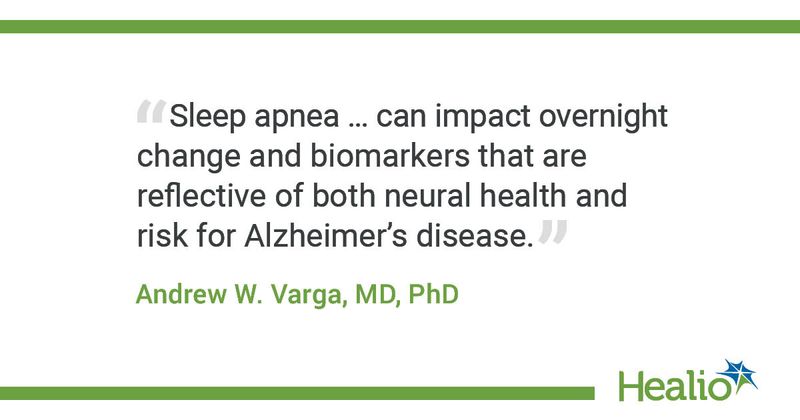Untreated sleep apnea may impact risk for Alzheimer’s disease
A new study demonstrated that obstructive sleep apnea has an acute effect on biomarkers for Alzheimer’s disease and the ability to measure such biomarkers from blood.
Moreover, withdrawal of positive airway pressure therapy was associated with changes in Alzheimer’s disease biomarkers, which researchers concluded

“There had been a lot of evidence suggesting that there are associations between sleep apnea and Alzheimer’s risk, but the question of treatment and treatment withdrawal on a fast timescale had never been addressed,” Andrew W. Varga, MD, PhD, associate professor in the department of medicine in the division of pulmonary, critical care and sleep medicine at Icahn School of Medicine at Mount Sinai, told Healio.
This study, published in American Journal of Respiratory and Critical Care Medicine, included 30 participants with severe OSA (mean age, 51.5 years; 27% women; 67% non-Hispanic white). Researchers collected blood from these participants at 10:40 p.m. and the next day at 6:40 a.m. across a night of polysomnography-recorded sleep during conditions of therapeutic PAP or the third consecutive night off PAP, which was defined as acute withdrawal. Overnight change was defined as the post-sleep measure subtracting the pre-sleep measure for plasma neurofilament light, total tau, amyloid beta 42 and amyloid beta 40 proteins.
The researchers reported significant differences in sleep architecture measures between untreated OSA vs. PAP-treated nights.
Researchers observed significant overnight change in neurofilament light and amyloid beta 40 in participants with severe OSA.
PAP withdrawal resulted in an increase in neurofilament light and a decrease in amyloid beta 40. There were no differences in total tau and amyloid beta 42 between conditions. However, at the beginning of sleep, all four biomarkers for Alzheimer’s disease were not different between sleep conditions.
In addition, the number of sleep stage transitions, a marker of sleep fragmentation, and the amount of time below 90% oxygen saturation were all significantly associated with neurofilament light phenomena caused by PAP withdrawal, the researchers reported. However, they did not identify sleep or respiratory measures that predicted overnight amyloid beta 40 change.
“Sleep apnea, even very quickly across one night, can impact overnight change and biomarkers that are reflective of both neural health and risk for Alzheimer’s disease,” Varga told Healio.
This study was limited to exclude a high number of total tau samples, according to the researchers. Varga said future studies should investigate total tau levels in relation to sleep apnea.
“Our approach was to take people who we already know are good PAP users at home, and to do this acute withdrawal experiment. So, they use their PAP as they ordinarily would at home and then once a different time when we asked them to discontinue PAP acutely,” Varga said. “But that would make you think that if you took someone who’s newly diagnosed with sleep apnea, who’s never been on therapy, and then suddenly gets on PAP therapy that you should see similar things across weeks or months of PAP use, but that’s never really been addressed.”
According to Varga, moving forward, studies looking at acute effects on tau and phosphorylated versions of tau and experiments addressing these changes with newly diagnosed patients with OSA and weeks/months later after being on PAP therapy are needed.
For more information:
Andrew W. Varga, MD, PhD, can be reached at andrew.varga@mssm.edu.
